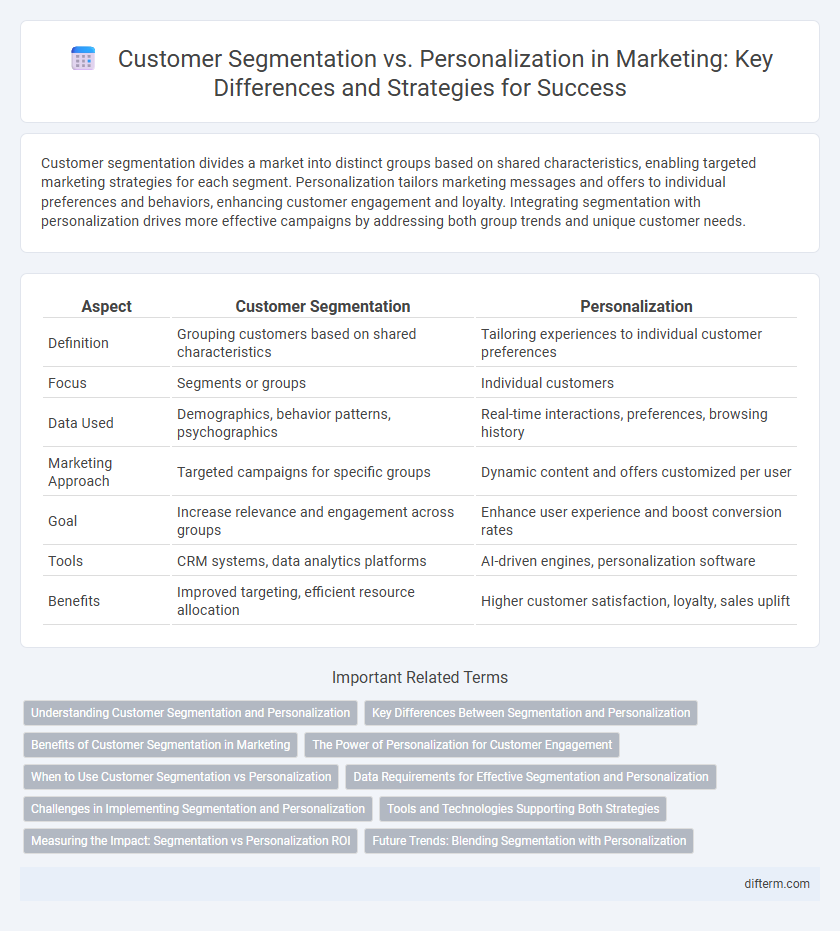Customer segmentation divides a market into distinct groups based on shared characteristics, enabling targeted marketing strategies for each segment. Personalization tailors marketing messages and offers to individual preferences and behaviors, enhancing customer engagement and loyalty. Integrating segmentation with personalization drives more effective campaigns by addressing both group trends and unique customer needs.
Table of Comparison
| Aspect | Customer Segmentation | Personalization |
|---|---|---|
| Definition | Grouping customers based on shared characteristics | Tailoring experiences to individual customer preferences |
| Focus | Segments or groups | Individual customers |
| Data Used | Demographics, behavior patterns, psychographics | Real-time interactions, preferences, browsing history |
| Marketing Approach | Targeted campaigns for specific groups | Dynamic content and offers customized per user |
| Goal | Increase relevance and engagement across groups | Enhance user experience and boost conversion rates |
| Tools | CRM systems, data analytics platforms | AI-driven engines, personalization software |
| Benefits | Improved targeting, efficient resource allocation | Higher customer satisfaction, loyalty, sales uplift |
Understanding Customer Segmentation and Personalization
Understanding customer segmentation involves categorizing consumers based on shared characteristics such as demographics, behavior, or purchasing patterns to tailor marketing strategies effectively. Personalization goes a step further by delivering individualized content, product recommendations, and communication that resonate with each customer's unique preferences and needs. Both approaches enhance marketing efficiency, but personalization drives deeper engagement by creating customized experiences that increase customer loyalty and conversion rates.
Key Differences Between Segmentation and Personalization
Customer segmentation divides a broad market into distinct groups based on shared characteristics such as demographics, behavior, or purchasing patterns, enabling targeted marketing strategies. Personalization tailors individual customer experiences in real-time by leveraging data analytics and AI to address unique preferences and needs. While segmentation focuses on group-level marketing efficiency, personalization drives one-to-one engagement and higher customer satisfaction.
Benefits of Customer Segmentation in Marketing
Customer segmentation enhances marketing efficiency by categorizing audiences based on demographics, behavior, and preferences, enabling precise targeting and resource allocation. It improves campaign ROI by delivering relevant messaging that resonates with distinct customer groups, increasing engagement and conversion rates. Businesses leveraging customer segmentation also gain insights into market trends and consumer needs, facilitating product development and competitive advantage.
The Power of Personalization for Customer Engagement
Personalization harnesses customer data to deliver tailored experiences that significantly increase engagement and loyalty, driving higher conversion rates. Unlike broad customer segmentation, which categorizes audiences into groups, personalization addresses individual preferences and behaviors in real time. This targeted approach boosts ROI by creating meaningful interactions that resonate uniquely with each customer's needs.
When to Use Customer Segmentation vs Personalization
Customer segmentation is ideal when targeting broad groups with shared characteristics such as demographics, purchasing behavior, or geographic location, enabling efficient allocation of marketing resources. Personalization excels when delivering tailored experiences and messages to individual customers based on real-time data, preferences, and interactions. Choose customer segmentation for scalable campaigns and personalization for enhancing customer engagement and loyalty through customized communication.
Data Requirements for Effective Segmentation and Personalization
Effective customer segmentation requires comprehensive demographic, behavioral, and psychographic data to identify distinct groups within a target audience. Personalization demands real-time, individual-level data including browsing history, purchase patterns, and engagement metrics to tailor unique customer experiences. Both strategies rely heavily on data accuracy, integration from multiple sources, and robust analytics platforms to maximize marketing impact.
Challenges in Implementing Segmentation and Personalization
Customer segmentation faces challenges such as collecting accurate data, managing large data sets, and defining clear segment criteria to avoid overlaps. Personalization struggles with integrating real-time data, delivering consistent experiences across channels, and maintaining privacy compliance under evolving regulations like GDPR and CCPA. Both strategies require advanced analytics tools and skilled teams to interpret data insights effectively for targeted marketing campaigns.
Tools and Technologies Supporting Both Strategies
Customer segmentation relies on data analytics platforms and CRM systems to categorize consumers based on demographics, behavior, and purchase history, enabling targeted marketing campaigns. Personalization utilizes AI-driven recommendation engines, machine learning algorithms, and real-time data processing tools to deliver individualized content and offers at scale. Integration of tools like predictive analytics, automation software, and customer data platforms (CDPs) supports both strategies by enhancing accuracy and efficiency in delivering relevant customer experiences.
Measuring the Impact: Segmentation vs Personalization ROI
Measuring ROI in customer segmentation focuses on analyzing group-specific engagement metrics, conversion rates, and cost efficiency across defined demographics or behaviors. Personalization ROI emphasizes increased customer lifetime value, higher click-through rates, and improved retention driven by tailored content and experiences. Both strategies require advanced analytics tools to track performance and optimize marketing spend effectively.
Future Trends: Blending Segmentation with Personalization
Future marketing trends emphasize the integration of customer segmentation with personalization to enhance targeting precision and customer experience. Advanced AI-driven analytics enable dynamic segmentation that adapts in real time, allowing personalized content delivery tailored to evolving consumer behaviors. This blend fosters deeper customer engagement and optimizes ROI by leveraging data to anticipate preferences before purchase decisions occur.
Customer segmentation vs personalization Infographic

 difterm.com
difterm.com